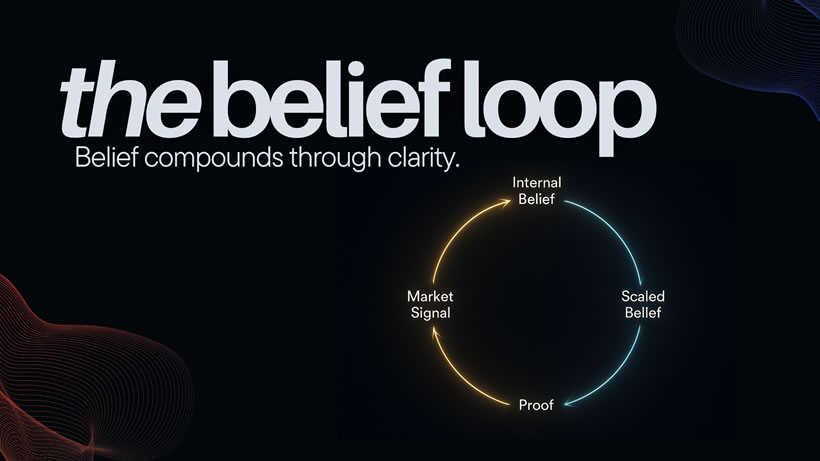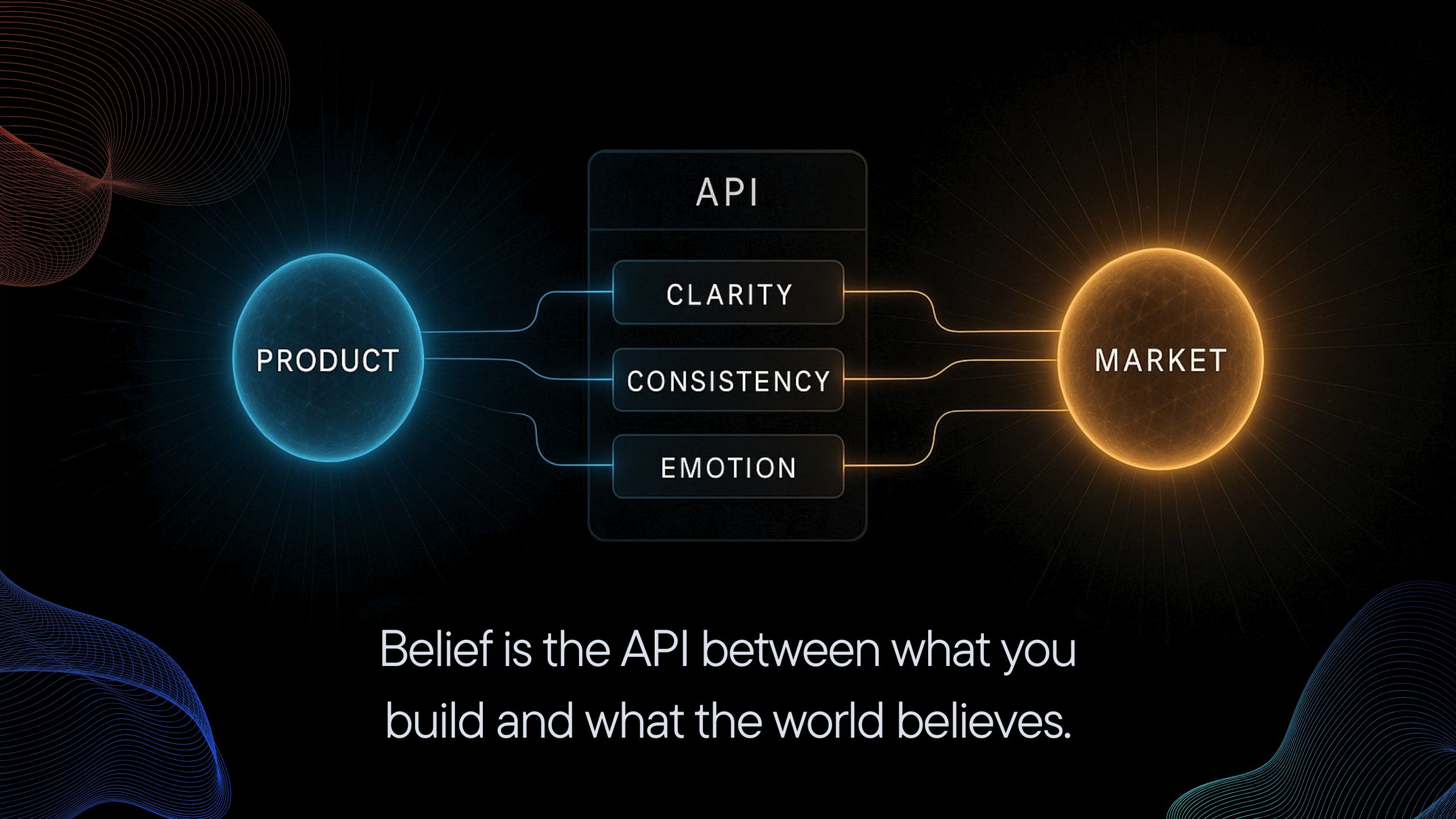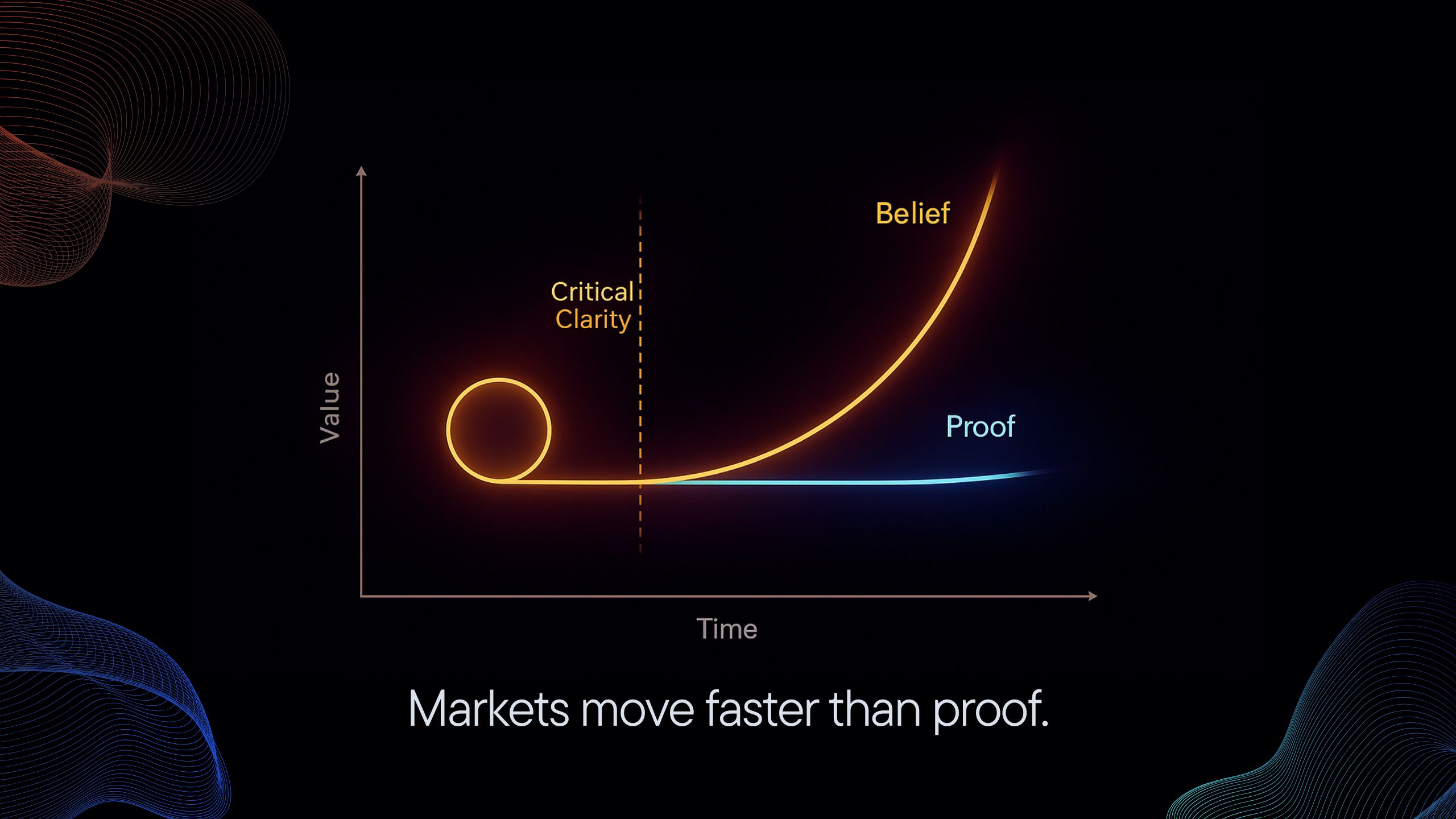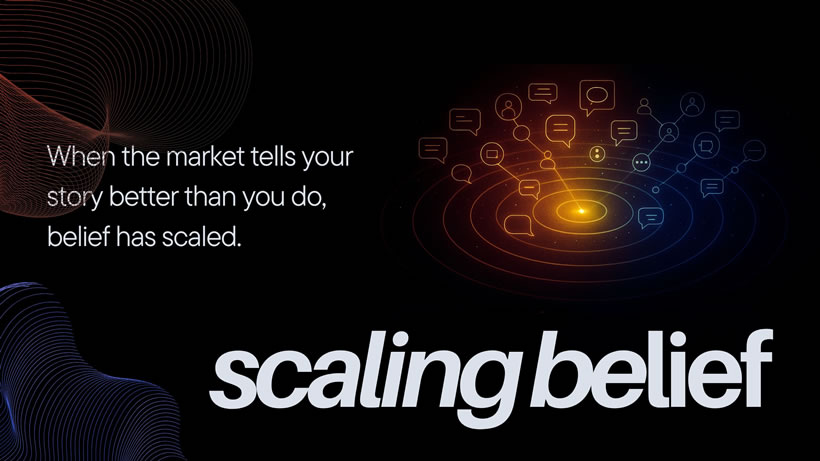Summary
Technical brilliance earns attention. Market belief earns scale.
Every founder eventually learns this—the hard way.
You can have the smartest product in the room and still watch someone with half your capabilities outgrow you. I’ve seen it happen dozens of times over 25 years. The better technology loses. The better story wins.
Why? Because they built belief while you were still perfecting proof. And here’s what most people get wrong: belief is not luck. It’s not charisma. It’s not a well-timed press cycle or a founder who’s good on podcasts. Belief is a system. Measurable, repeatable, engineerable.
You build market belief the same way you build a product: through feedback loops, testing, and iteration. When it compounds, it becomes the most powerful form of network effect there is because once the market starts explaining your product better than you do—you’ve achieved scale.

The Science of Earned Belief
Markets don’t scale on logic, they scale on emotion. That doesn’t mean they’re irrational. It means they move faster than proof. Human decision-making always does.
Behavioral economists have studied this for decades, we make decisions based on how we think something will make us feel, not just what it can technically do. That’s not a bug in how markets work. It’s a feature. The data backs this up: in B2B software, the majority of the buying decision is made before a prospect ever talks to sales. They’ve already formed a belief about whether you can solve their problem. Your demo doesn’t create that belief, it confirms or contradicts it.
So the companies that win are the ones that understand emotion isn’t separate from the buying process. It’s the accelerant. They build belief not as an afterthought, but as infrastructure. As something designed into the go-to-market motion from day one.
It’s not about hype. It’s about anticipation.
You’re not using storytelling for its own sake, you’re building story systems that scale. The goal is operational trust that compounds through every interaction, not some simple “brand love.”
When you approach it this way, belief becomes an engineered outcome, not a happy accident.

Two Architectures, Not One
Every startup has two architectures: The codebase, and the conviction base.
- The code defines what the product can do.
- The conviction defines what the market believes it can do.
The uncomfortable truth I’ve learned is that most founders obsess over technical architecture while treating narrative architecture like an afterthought. Like something you figure out when it’s time to “tell the story.” But that’s backwards.
Just like software, belief requires architecture. It needs:
- Version control: How your story evolves as the product matures and the market shifts
- Documentation: How you onboard people into your vision so the 500th person hears the same coherent story as the first
- Testing: How you validate narrative resonance before you scale it
- Rollbacks: How you recover when the market misunderstands you or when your positioning misses
I learned this working with developers. The technical teams had immaculate documentation; every API endpoint, every integration path, every edge case covered.
But the marketing narrative? It lived in someone’s head. Different people on the team explained what the product did differently. Sales decks contradicted the website. The messaging changed routinely based on whoever had the CEO’s ear.
The product was beautifully architected. The belief system was chaos.
And here’s what happens when narrative architecture is weak: even if someone understands your product, they can’t explain it to someone else. Your belief system doesn’t propagate. It dies in the first conversation.
Belief is an API between product and market. If it’s poorly structured, no one can integrate with it.

The Feedback Loop of Conviction
Belief doesn’t just happen. It compounds through a specific loop that you can measure and optimize:
Internal Belief → Market Signal
When teams are actually aligned around clarity, not just nodding in a meeting, but genuinely speaking the same language, customers feel it. Every interaction becomes an echo of conviction. The sales call matches the demo. The demo matches the documentation. The support team explains things the same way the founder does.
Internal coherence builds external momentum. I’ve watched companies transform their close rates not by changing their product, but by getting everyone to tell the same coherent story.
Market Signal → Proof
Once the market reacts, you measure it. Not just vanity metrics, actual signal.
Are people using your language back to you? Are they explaining your product to others accurately? Are the right buyers raising their hands? Are the wrong ones filtering themselves out?
This feedback sharpens your proof points. You learn which parts of the narrative resonate and which parts create friction. You iterate.

Proof → Scaled Belief
Proof validates narrative. The story gets stronger, cleaner, faster with each cycle. Early customers become references. Those references become case studies. Those case studies become patterns. Those patterns become category definitions.
Soon, the market carries the story for you. Analysts start using your framing. Competitors position against you. Buyers assume you’re the standard. That’s the loop. That’s what belief-as-a-system looks like.
It starts with internal clarity and ends in compounding trust that scales beyond your control, in the best possible way.

Clarity Without Flattening
Here’s the trap I’ve seen founders fall into repeatedly: They try to simplify what makes them complex.
Someone tells them “your messaging is too technical” or “you need a simpler value prop,” so they strip out everything interesting about what they do. They turn nuance into slogans. Depth into sound bites. And then they wonder why nobody believes them.
Because clarity isn’t the opposite of complexity. It’s the management of it.
The best companies I’ve worked with don’t dumb down their product. They layer it. They build structured on-ramps for different audiences:
Layer 1: Vision — the emotional why. The world as it is versus the world as it could be. This is what gets attention. This is what makes someone lean in.
Layer 2: Proof — the logical how. This is where you earn credibility. How it works, why it’s different, what makes it possible now when it wasn’t before.
Layer 3: Depth — the technical what. The architecture, the methodology, the specifics that technical buyers need to feel confident.
Each layer earns the right to the next. You don’t lead with layer three. But you don’t hide it either. Because the people who need that depth will go looking for it, and if it’s not there, they won’t believe layers one and two.
This keeps your clarity scalable without flattening your depth because simplicity isn’t what makes people believe. Consistency does and consistency is just clarity, operationalized across every touchpoint.

When Belief Becomes Self-Replicating
When belief is designed well, something remarkable happens: it doesn’t just scale, it self-replicates.
Users start teaching each other, not because you asked them to, but because they have language that makes sense and they want to share it.
Analysts start citing your framing, not because you paid them, but because you named something that needed a name.
The market starts explaining your product back to you, only faster, cleaner, and more convincingly than you ever did.
I’ve been in rooms where founders hear a customer describe their product and think, “That’s better than our pitch deck.” That’s the moment you know it’s working. That’s the moment you stop running a company and start running a movement because belief spreads like open source code. It forks, improves, and evolves in public.
Your job isn’t to control it. It’s to maintain the core integrity while enabling the ecosystem to grow. That’s how product-led growth becomes belief-led growth. That’s how you build a category instead of just a company.

The Only Sustainable Moat
Here’s what I’ve learned after watching hundreds of companies rise and fall:
Every technology advantage eventually erodes. Every feature gets replicated. Every algorithm gets copied. Every model gets commoditized. Every “secret sauce” gets reverse-engineered.
But belief? Belief endures.
Belief is the compound interest of clarity. It’s the only asset that appreciates even when the market shifts. It’s what makes talent choose you over higher-paying offers. It’s what makes partners commit before the deal is signed. It’s what makes customers advocate when they have nothing to gain. And unlike features, it can’t be cloned.
Why? Because belief is trust at scale, and trust is earned through consistency over time, not engineered through feature velocity. You can’t shortcut it. You can’t buy it with ad spend. You can’t fake it with PR. You have to build it. Interaction by interaction. Story by story. Proof point by proof point.
That’s the work. That’s the discipline.

The New Discipline of Growth
The future CMO, CRO, or founder won’t just be a storyteller, they’ll be a belief architect. Someone who understands that emotion isn’t a tactic, it’s an accelerant for decision-making. That clarity isn’t copywriting, it’s infrastructure that enables everything else. That narrative isn’t fluff, it’s the framework that turns innovation into inevitability.
When you treat belief like a discipline, not an accident, your market stops feeling like a mystery.
You can measure it: How many people are using your language? How accurately can customers explain your value? How often does belief propagate without your involvement?
You can design for it: What needs to be true at each layer? What stories unlock the next level of conviction? What proof points remove the most friction?
You can compound it: Every customer interaction adds to the belief base. Every piece of content reinforces the core narrative. Every proof point makes the next sale easier.

That’s how category leaders are made. Not by shouting louder, but by making belief inevitable. By building conviction and capability in parallel versus perfecting the technology first.
Technical brilliance earns attention and will get you in the room. It also gets you the meeting and respect from people who understand what you built.
But market belief? Market belief earns scale. It’s what turns attention into adoption. Adoption into advocacy. Advocacy into category dominance.
The companies that figure out how to engineer it, systematically, repeatably, deliberately, are the ones that don’t just win their market. They define it.

